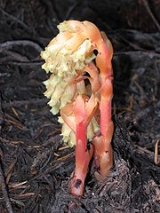
Monotropa
Encyclopedia
Monotropa is a genus of two species of herbaceous
perennial plant
s, formerly classified in the family Monotropaceae
, but now included within the Ericaceae
. They are native to temperate regions of the Northern Hemisphere
, but are generally scarce or rare.
Unlike most plants, they do not contain chlorophyll
; they are myco-heterotrophs, getting their food through parasitism
upon fungi rather than photosynthesis
. Thus they are capable of living in very dark conditions, such as the floor of deep forest
s, because they do not need any sunlight.
Species
Herbaceous
A herbaceous plant is a plant that has leaves and stems that die down at the end of the growing season to the soil level. They have no persistent woody stem above ground...
perennial plant
Perennial plant
A perennial plant or simply perennial is a plant that lives for more than two years. The term is often used to differentiate a plant from shorter lived annuals and biennials. The term is sometimes misused by commercial gardeners or horticulturalists to describe only herbaceous perennials...
s, formerly classified in the family Monotropaceae
Monotropaceae
Monotropaceae was a small family of flowering plants under the old Cronquist system of plant classification. It included 10 genera Allotropa, Cheilotheca, Hemitomes, Monotropa, Monotropastrum, Monotropsis, Pityopus, Pleuricospora, Pterospora, Sarcodes....
, but now included within the Ericaceae
Ericaceae
The Ericaceae, commonly known as the heath or heather family, is a group of mostly calcifuge flowering plants. The family is large, with roughly 4000 species spread across 126 genera, making it the 14th most speciose family of flowering plants...
. They are native to temperate regions of the Northern Hemisphere
Northern Hemisphere
The Northern Hemisphere is the half of a planet that is north of its equator—the word hemisphere literally means “half sphere”. It is also that half of the celestial sphere north of the celestial equator...
, but are generally scarce or rare.
Unlike most plants, they do not contain chlorophyll
Chlorophyll
Chlorophyll is a green pigment found in almost all plants, algae, and cyanobacteria. Its name is derived from the Greek words χλωρος, chloros and φύλλον, phyllon . Chlorophyll is an extremely important biomolecule, critical in photosynthesis, which allows plants to obtain energy from light...
; they are myco-heterotrophs, getting their food through parasitism
Parasitism
Parasitism is a type of symbiotic relationship between organisms of different species where one organism, the parasite, benefits at the expense of the other, the host. Traditionally parasite referred to organisms with lifestages that needed more than one host . These are now called macroparasites...
upon fungi rather than photosynthesis
Photosynthesis
Photosynthesis is a chemical process that converts carbon dioxide into organic compounds, especially sugars, using the energy from sunlight. Photosynthesis occurs in plants, algae, and many species of bacteria, but not in archaea. Photosynthetic organisms are called photoautotrophs, since they can...
. Thus they are capable of living in very dark conditions, such as the floor of deep forest
Forest
A forest, also referred to as a wood or the woods, is an area with a high density of trees. As with cities, depending where you are in the world, what is considered a forest may vary significantly in size and have various classification according to how and what of the forest is composed...
s, because they do not need any sunlight.
Species
- Monotropa hypopitysMonotropa hypopitysMonotropa hypopitys, also known as Dutchman's Pipe, Yellow Bird's-nest or Pinesap, is a herbaceous perennial plant, formerly classified in the families Monotropaceae or Pyrolaceae, but now included within the subfamily Monotropoidiae of the blueberry family...
- Monotropa unifloraMonotropa unifloraMonotropa uniflora, also known as the Ghost Plant, Indian Pipe, or Corpse Plant is a herbaceous perennial plant, formerly classified in the family Monotropaceae, but now included within the Ericaceae. It is native to temperate regions of Asia, North America and northern South America, but with...

